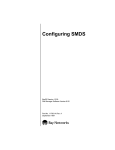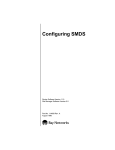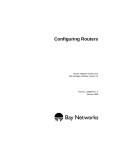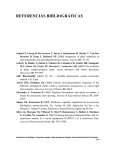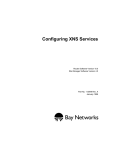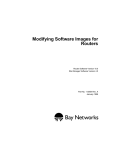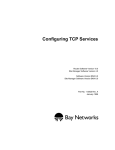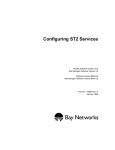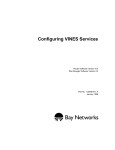Download Avaya Configuring SMDS Services User's Manual
Transcript
Configuring SMDS Services Router Software Version 10.0 Site Manager Software Version 4.0 Software Version BNX 6.0 Site Manager Software Version BNX 6.0 Part No. 112922 Rev. A January 1996 4401 Great America Parkway Santa Clara, CA 95054 8 Federal Street Billerica, MA 01821 Copyright © 1988–1996 Bay Networks, Inc. All rights reserved. Printed in the USA. January 1996. The information in this document is subject to change without notice. The statements, configurations, technical data, and recommendations in this document are believed to be accurate and reliable, but are presented without express or implied warranty. Users must take full responsibility for their applications of any products specified in this document. The information in this document is proprietary to Bay Networks, Inc. The software described in this document is furnished under a license agreement and may only be used in accordance with the terms of that license. A summary of the Software License is included in this document. Restricted Rights Legend Use, duplication, or disclosure by the United States Government is subject to restrictions as set forth in subparagraph (c)(1)(ii) of the Rights in Technical Data and Computer Software clause at DFARS 252.227-7013. Notice for All Other Executive Agencies Notwithstanding any other license agreement that may pertain to, or accompany the delivery of, this computer software, the rights of the United States Government regarding its use, reproduction, and disclosure are as set forth in the Commercial Computer Software-Restricted Rights clause at FAR 52.227-19. Trademarks of Bay Networks, Inc. ACE, AFN, BCN, BLN, BN, CN, FRE, LN, Optivity, SynOptics, SynOptics Communications, Wellfleet and the Wellfleet logo are registered trademarks and AN, ANH, ASN, BaySIS, BayStack, BCNX, BLNX, BNX, EZ Internetwork, EZ LAN, FN, PathMan, PhonePlus, PPX, Quick2Config, RouterMan, SPEX, Bay Networks, Bay Networks Press, the Bay Networks logo and the SynOptics logo are trademarks of Bay Networks, Inc. Third-Party Trademarks All other trademarks and registered trademarks are the property of their respective owners. Statement of Conditions In the interest of improving internal design, operational function, and/or reliability, Bay Networks, Inc. reserves the right to make changes to the products described in this document without notice. Bay Networks, Inc. does not assume any liability that may occur due to the use or application of the product(s) or circuit layout(s) described herein. Portions of the code in this software product are Copyright © 1988, Regents of the University of California. All rights reserved. Redistribution and use in source and binary forms of such portions are permitted, provided that the above copyright notice and this paragraph are duplicated in all such forms and that any documentation, advertising materials, and other materials related to such distribution and use acknowledge that such portions of the software were developed by the University of California, Berkeley. The name of the University may not be used to endorse or promote products derived from such portions of the software without specific prior written permission. SUCH PORTIONS OF THE SOFTWARE ARE PROVIDED “AS IS” AND WITHOUT ANY EXPRESS OR IMPLIED WARRANTIES, INCLUDING, WITHOUT LIMITATION, THE IMPLIED WARRANTIES OF MERCHANTABILITY AND FITNESS FOR A PARTICULAR PURPOSE. In addition, the program and information contained herein are licensed only pursuant to a license agreement that contains restrictions on use and disclosure (that may incorporate by reference certain limitations and notices imposed by third parties). Bay Networks Software License Note: This is Bay Networks basic license document. In the absence of a software license agreement specifying varying terms, this license — or the license included with the particular product — shall govern licensee’s use of Bay Networks software. This Software License shall govern the licensing of all software provided to licensee by Bay Networks (“Software”). Bay Networks will provide licensee with Software in machine-readable form and related documentation (“Documentation”). The Software provided under this license is proprietary to Bay Networks and to third parties from whom Bay Networks has acquired license rights. Bay Networks will not grant any Software license whatsoever, either explicitly or implicitly, except by acceptance of an order for either Software or for a Bay Networks product (“Equipment”) that is packaged with Software. Each such license is subject to the following restrictions: 1. Upon delivery of the Software, Bay Networks grants to licensee a personal, nontransferable, nonexclusive license to use the Software with the Equipment with which or for which it was originally acquired, including use at any of licensee’s facilities to which the Equipment may be transferred, for the useful life of the Equipment unless earlier terminated by default or cancellation. Use of the Software shall be limited to such Equipment and to such facility. Software which is licensed for use on hardware not offered by Bay Networks is not subject to restricted use on any Equipment, however, unless otherwise specified on the Documentation, each licensed copy of such Software may only be installed on one hardware item at any time. 2. Licensee may use the Software with backup Equipment only if the Equipment with which or for which it was acquired is inoperative. 3. Licensee may make a single copy of the Software (but not firmware) for safekeeping (archives) or backup purposes. 4. Licensee may modify Software (but not firmware), or combine it with other software, subject to the provision that those portions of the resulting software which incorporate Software are subject to the restrictions of this license. Licensee shall not make the resulting software available for use by any third party. 5. Neither title nor ownership to Software passes to licensee. 6. Licensee shall not provide, or otherwise make available, any Software, in whole or in part, in any form, to any third party. Third parties do not include consultants, subcontractors, or agents of licensee who have licensee’s permission to use the Software at licensee’s facility, and who have agreed in writing to use the Software only in accordance with the restrictions of this license. 7. Third-party owners from whom Bay Networks has acquired license rights to software that is incorporated into Bay Networks products shall have the right to enforce the provisions of this license against licensee. 8. Licensee shall not remove or obscure any copyright, patent, trademark, trade secret, or similar intellectual property or restricted rights notice within or affixed to any Software and shall reproduce and affix such notice on any backup copy of Software or copies of software resulting from modification or combination performed by licensee as permitted by this license. Bay Networks, Inc. 4401 Great America Parkway, Santa Clara, CA 95054 8 Federal Street, Billerica, MA 01821 Bay Networks Software License (continued) 9. Licensee shall not reverse assemble, reverse compile, or in any way reverse engineer the Software. [Note: For licensees in the European Community, the Software Directive dated 14 May 1991 (as may be amended from time to time) shall apply for interoperability purposes. Licensee must notify Bay Networks in writing of any such intended examination of the Software and Bay Networks may provide review and assistance.] 10. Notwithstanding any foregoing terms to the contrary, if licensee licenses the Bay Networks product “Site Manager,” licensee may duplicate and install the Site Manager product as specified in the Documentation. This right is granted solely as necessary for use of Site Manager on hardware installed with licensee’s network. 11. This license will automatically terminate upon improper handling of Software, such as by disclosure, or Bay Networks may terminate this license by written notice to licensee if licensee fails to comply with any of the material provisions of this license and fails to cure such failure within thirty (30) days after the receipt of written notice from Bay Networks. Upon termination of this license, licensee shall discontinue all use of the Software and return the Software and Documentation, including all copies, to Bay Networks. 12. Licensee’s obligations under this license shall survive expiration or termination of this license. Bay Networks, Inc. 4401 Great America Parkway, Santa Clara, CA 95054 8 Federal Street, Billerica, MA 01821 Contents About This Guide Software Suites ................................................................................................................ xi Audience ...........................................................................................................................xii Before You Begin ..............................................................................................................xii Bay Networks Customer Support .....................................................................................xii CompuServe .............................................................................................................xiii InfoFACTS .................................................................................................................xiv World Wide Web ........................................................................................................xiv How to Get Help ..............................................................................................................xiv Conventions .....................................................................................................................xiv Ordering Bay Networks Publications ............................................................................... xv Acronyms .........................................................................................................................xvi Chapter 1 SMDS Overview How SMDS Sends LAN Data over WANs .......................................................................1-2 SMDS Interface Protocol ................................................................................................1-3 Data Exchange Interface Protocol ..................................................................................1-4 PDU Assembly .........................................................................................................1-5 SMDS Individual Addresses ...........................................................................................1-7 SMDS Group Addresses ................................................................................................1-7 For More Information about SMDS .................................................................................1-7 Chapter 2 Implementation Notes Requirements for the Router and the DSU/CSU ............................................................2-3 DXI Protocol Requirements ......................................................................................2-3 Local Management Interface ....................................................................................2-3 Protocols Supported by SMDS .......................................................................................2-4 Priority of Heartbeat Poll Messages ...............................................................................2-4 v Multinet ...........................................................................................................................2-5 Multigroup .......................................................................................................................2-7 Configuring Synchronous Lines for SMDS ...................................................................2-10 Chapter 3 Enabling SMDS Using the MIB Object ID .................................................................................................3-1 Enabling SMDS on an Interface .....................................................................................3-2 Chapter 4 Editing SMDS Parameters Editing SMDS Interface Parameters ...............................................................................4-2 SMDS Interface Parameter Descriptions .................................................................4-4 Deleting SMDS from the Router .....................................................................................4-8 Appendix A SMDS Default Settings Index vi Figures Figure 1-1. Figure 1-2. Figure 1-3. Figure 1-4. Figure 1-5. Figure 2-1. Figure 2-2. Figure 2-3. Figure 2-4. Figure 2-5. Figure 2-6. Figure 2-7. Figure 3-1. Figure 4-1. Figure 4-2. SMDS Sample Network ...........................................................................1-2 SMDS Interface Protocol Stack ...............................................................1-3 SMDS Level-3 PDU .................................................................................1-4 DXI Protocol .............................................................................................1-5 DXI Packet Assembly ...............................................................................1-6 Access to SMDS Network via a Router and DSU/CSU ...........................2-1 Low-Speed Access to SMDS Network .....................................................2-2 Low-Speed Access to SMDS Network via a Low-Speed DSU ................2-2 SMDS and IP Addresses for a Multinet Configuration .............................2-5 Multinet Configuration ..............................................................................2-6 Multigrouping SMDS and IP Addresses ...................................................2-7 Multigroup Configuration ..........................................................................2-9 SMDS Configuration Window ...................................................................3-2 Configuration Manager Window ...............................................................4-2 SMDS Interface List Window ...................................................................4-3 vii Tables Table 2-1. Table A-1. Synchronous Line Parameter Settings for SMDS ..................................2-10 SMDS Interface Parameters ................................................................... A-1 ix About This Guide If you are responsible for configuring and managing Bay Networks routers or BNX platforms, read this guide to learn how to customize Bay Networks software for Switched Multimegabit Data Services (SMDS). This guide, Configuring SMDS Services, offers • An overview of the SMDS protocol (see Chapter 1) • Implementation notes that may affect how you configure SMDS (see Chapter 2) • Instructions on enabling SMDS on your router (see Chapter 3) • Instructions on editing SMDS interface parameters and configuring SMDS (see Chapter 4) Software Suites Routing and Switching software is available in the following suites: • The System Suite includes IP routing, 802.1 Transparent Bridge, Source Route Bridge, Translation Bridge, SNMP Agent, Bay Networks HDLC, PPP, OSPF, EGP, BGP, and basic DLSw. • The LAN Suite includes DECnet Phase 4, AppleTalk Phase 2, OSI, VINES, IPX, and ATM DXI, in addition to the System Suite. • The WAN Suite includes ATM DXI, Frame Relay, LAPB, and X.25, in addition to the System Suite. • The Corporate Suite includes the System, LAN, and WAN suites in their entirety. • The ARE ATM Suite provides RFC 1483 and 1577 compliance, ATM UNI 3.0 signaling, in addition to the LAN Suite. xi Configuring SMDS Services • The ARE VNR Corporate Suite provides ATM Forum LAN Emulation, in addition to the ARE ATM Suite and Corporate Suite. • The BNX Suite includes IP Routing, SNMP Agent, Bay Networks HDLC, PPP, OSPF, EGP, BGP, File-Based Performance Statistics, Frame Relay switching, and Frame Relay billing, and selected components from the Corporate, ARE ATM, and ARE VNR Corporate suites. Availability of features and functionality described in this guide depends on the suites you are using. Audience Written for system and network managers, this guide provides instructions on how to configure the Bay Networks implementation of SMDS interfaces to suit your environment. We assume that you have experience with LANs and WANs, SMDS, and general network management tasks. Before You Begin Before using this guide, you must complete the following procedures: • Create and save a configuration file that has at least one SMDS interface. • Retrieve the configuration file in local, remote, or dynamic mode. For instructions, refer to Configuring Routers or Configuring Customer Access and Trunks (BNX Software), depending on the type of installed software. Bay Networks Customer Support Bay Networks provides live telephone technical support to our distributors, resellers, and service-contracted customers from two U.S. and three international support centers. If you have purchased your Bay Networks product from a distributor or authorized reseller, contact the technical support staff of that distributor or reseller for assistance with installation, configuration, troubleshooting, or integration issues. xii About This Guide Customers also have the option of purchasing direct support from Bay Networks through a variety of service programs. The programs include priority access telephone support, on-site engineering assistance, software subscription, hardware replacement, and other programs designed to protect your investment. To purchase any of these support programs, including PhonePlus™ for 24-hour telephone technical support, call 1-800-2LANWAN. Outside the U.S. and Canada, call (408) 764-1000. You can also receive information on support programs from your local Bay Networks field sales office, or purchase Bay Networks support directly from your reseller. Bay Networks provides several methods of receiving support and information on a nonpriority basis through the following automated systems. CompuServe Bay Networks maintains an active forum on CompuServe. All you need to join us online is a computer, a modem, and a CompuServe account. We also recommend using the CompuServe Information Manager software, available from CompuServe. The Bay Networks forum contains libraries of technical and product documents designed to help you manage and troubleshoot your Bay Networks products. Software agents and patches are available, and the message boards are monitored by technical staff and can be a source for problem solving and shared experiences. Customers and resellers holding Bay Networks service contracts can visit the special libraries to acquire advanced levels of support documentation and software. To open an account and receive a local dial-up number, call CompuServe at 1-800-524-3388 and ask for Representative No. 591. • In the United Kingdom, call Freephone 0800-289378. • In Germany, call 0130-37-32. • In Europe (except for the United Kingdom and Germany), call (44) 272-760681. • Outside the U.S., Canada, and Europe, call (614) 529-1349 and ask for Representative No. 591, or consult your listings for an office near you. Once you are online, you can reach our forum by typing the command GO BAYNETWORKS at any ! prompt. xiii Configuring SMDS Services InfoFACTS InfoFACTS is the Bay Networks free 24-hour fax-on-demand service. This automated system contains libraries of technical and product documents designed to help you manage and troubleshoot your Bay Networks products. The system can return a fax copy to the caller or to a third party within minutes of being accessed. World Wide Web The World Wide Web (WWW) is a global information system for file distribution and online document viewing via the Internet. You need a direct connection to the Internet and a Web Browser (such as Mosaic or Netscape). Bay Networks maintains a WWW Home Page that you can access at http:// www.baynetworks.com. One of the menu items on the Home Page is the Customer Support Web Server, which offers technical documents, software agents, and an E-mail capability for communicating with our technical support engineers. How to Get Help For additional information or advice, contact the Bay Networks Technical Response Center in your area: United States Valbonne, France Sydney, Australia Tokyo, Japan 1-800-2LAN-WAN (33) 92-966-968 (61) 2-903-5800 (81) 3-328-005 Conventions This section describes the conventions used in this guide. angle brackets (< >) Indicate that you choose the text to enter based on the description inside the brackets. Do not type the brackets when entering the command. Example: if command syntax is ping <ip_address>, you enter ping 192.32.10.12 xiv About This Guide arrow character (➔) Separates menu and option names in instructions. Example: Protocols➔AppleTalk identifies the AppleTalk option in the Protocols menu. bold text Indicates text that you need to enter and command names in text. Example: Use the dinfo command. brackets ([ ]) Indicate optional elements. You can choose none, one, or all of the options. italic text Indicates variable values in command syntax descriptions, new terms, file and directory names, and book titles. quotation marks (“ ”) Indicate the title of a chapter or section within a book. screen text Indicates data that appears on the screen. Example: Set Bay Networks Trap Monitor Filters ellipsis points vertical line (|) . Horizontal (. . .) and vertical ( .. ) ellipsis points indicate omitted information. Indicates that you enter only one of the parts of the command. The vertical line separates choices. Do not type the vertical line when entering the command. Example: If the command syntax is show at routes | nets, you enter either show at routes or show at nets, but not both. Ordering Bay Networks Publications To purchase additional copies of this document or other Bay Networks publications, order by part number from Bay Networks Press™ at the following numbers. You may also request a free catalog of Bay Networks Press product publications. Phone: FAX - U.S./Canada: FAX - International: 1-800-845-9523 1-800-582-8000 1-916-939-1010 xv Configuring SMDS Services Acronyms xvi ARP Address Resolution Protocol ATM Asynchronous Transfer Mode CRC Cyclic Redundancy Check DSU/CSU Digital Service Unit/Channel Service Unit DS1 Digital Service, Level 1 DS3 Digital Service, Level 3 DXI data exchange interface HSSI high-speed serial interface IEEE Institute of Electrical and Electronic Engineers IP Internet Protocol IPX Internet Packet Exchange LAN local area network LMI Local Management Interface MAC media access control MAN metropolitan area network OSI Open Systems Interconnection OSPF Open Shortest Path First PDU protocol data unit PVCs permanent virtual circuits RIP Routing Information Protocol SIP SMDS Interface Protocol SMDS Switched Multimegabit Data Services SNI subscriber network interface SNMP Simple Network Management Protocol WAN wide area network XNS Xerox Network System Chapter 1 SMDS Overview Switched Multimegabit Data Service (SMDS) is a public, high-speed, packetswitched network service that enables you to connect local area networks (LANs) across wide area networks (WANs). SMDS technology combines cell relay technology and IEEE Standard 802.6, the link control protocol standard that controls cell transmission. To send information across the network, SMDS divides data into fixed 53-byte cells. The use of cell technology makes SMDS well suited for traffic that consumes high bandwidth for short periods of time. Figure 1-1 illustrates an SMDS network. In this illustration, LAN 1 communicates to LAN 2 and 3 through a router connected to an SMDS Digital Service Unit/ Channel Service Unit (DSU/CSU). The DSU/CSU changes the frame-based data from the router into cells that can then be sent across the SMDS network. 1-1 Configuring SMDS Services LAN 2 SMDS Network LAN 1 T3 Router SMDS Switch DSU/ CSU SNI DSU/ CSU SMDS Switch SNI Router LAN 3 T3 T3 Figure 1-1. DSU/ CSU SMDS Switch Router SNI SMDS Sample Network The point at which the DSU/CSU meets the network is the subscriber network interface (SNI). This is the access point to the SMDS network. Within the switching system of the SMDS network, T3 communication lines connect the network switches together. Because data traffic and network equipment are different for each SMDS customer, SMDS defines several access classes. Access classes are speeds at which data travels from the customer site to the network switch. SMDS currently offers six network access classes: 1.2 Mb/s, 4 Mb/s, 10 Mb/s, 16 Mb/s, 25 Mb/s, and 34 Mb/s. The 1.2 Mb/s class is for T1 lines. Classes 4 Mb/s through 34 Mb/s are for T3 lines. SMDS also offers low-speed SMDS classes, which operate at fractional T1/E1 speeds (56 Kb/s up to 64 Kb/s). How SMDS Sends LAN Data over WANs LAN data is typically connectionless data. This means that it has addressing information in each frame, so there is no need for a prior connection between the origination and destination devices. WAN data is typically connection-oriented data. This means that it needs a virtual circuit — that is, a predefined path across physical lines — between the two connection points prior to sending data. SMDS provides connectionless data transfer across a wide area network without establishing a logical end-to-end connection. 1-2 SMDS Overview SMDS Interface Protocol The SMDS Interface Protocol (SIP) defines SMDS addressing, formatting, framing, and error-detection requirements. The SIP has three levels that are similar to, but do not match, the protocol layers that make up the OSI protocol model. • Level 3 specifies the addressing, formatting, and encapsulation of packet data, referred to as Level-3 PDUs. • Level 2 specifies the segmentation of Level-3 Protocol Data Units (PDUs) into short, fixed-length SMDS cells, referred to as Level-2 PDUs. • Level 1 specifies the physical connectivity that enables transmission. Figure 1-2 illustrates the SIP protocol stack. Level 3 Encapsulates Data into PDUs Level 2 Segments Data into 53-byte PDUs Level 1 Prepares Level-2 PDUs for the Physical Medium Figure 1-2. SMDS Interface Protocol Stack SIP specifies that the SMDS source and destination addresses reside in the Level-3 PDU header (Figure 1-3). Each header contains a MAC-level address in an E.164 address format. E.164 formats are 64 bits long and provide both individual and multicast addresses. Network switches use the address information in the header to route the PDU to its destination. 1-3 Configuring SMDS Services Header Trailer LAN Packet Figure 1-3. SMDS Level-3 PDU One or more SMDS devices, for example DSUs and routers, can perform the tasks of the three SIP levels, as described in the next section. Data Exchange Interface Protocol For SMDS high-speed access classes, that is, speeds from 1.2 Mb/s to 34 Mb/s, the SMDS Interest Group (SIG) wanted to simplify the integration of SMDS into existing network equipment, and to hasten SMDS into the market. To do this, they divided the functions defined by the SIP levels between devices that handle local network packets (for example, a router) and devices that interface with the digital services provided by common carriers (a DSU/CSU). The Data Exchange Interface (DXI) protocol defines this division of tasks and describes the router and DSU/CSU relationship (Figure 1-4). Refer to the next section for more information. 1-4 SMDS Overview SMDS Network Router DSU/CSU SMDS Switch SMDS Switch DSU/CSU Router DXI protocol defines the router and DSU/CSU interface Figure 1-4. DXI Protocol For low-speed SMDS (56 Kb/s to 64 Kb/s), the DXI is extended out to the SMDS network. In this case, you do not need a special SMDS DSU/CSU. PDU Assembly SMDS PDU assembly begins when the router receives a network-generated packet. The router takes the entire packet and encapsulates it within a 36-byte header (containing addressing, length, and control information) and a 4-byte trailer (containing a CRC value), thereby creating an SMDS Level-3 PDU (Figure 1-5). The router next prepares the Level-3 PDU for transmission to the DSU/CSU by encapsulating it within a DXI header and trailer that provide control information. Upon receiving the DXI packet, the DSU/CSU strips the DXI header/trailer and divides the Level-3 PDU into fixed-length (44-byte) units called cells. The DSU/CSU encapsulates these cells within a 7-byte header and 2-byte trailer to form Level-2 PDUs. Finally, the DSU/CSU inserts an additional four bytes of framing information between each Level-2 PDU and transmits the framed cells across a Digital Service Level 1 (DS1) or DS3 connection to the SMDS network. Figure 1-5 shows the assembly of SMDS cells as specified by the DXI. 1-5 Configuring SMDS Services Router Receives LAN Packet Level-3 Encapsulation PAYLOAD PAYLOAD Router 36-byte header 4-byte trailer PAYLOAD DXI header DXI trailer DXI PAYLOAD Level-2 Segmentation 4-byte trailer DSU/CSU PAYLOAD 7-byte header 44-byte cell PAYLOAD 2-byte trailer 7-byte header PAYLOAD 44-byte cell 1-6 44-byte 2-byte cell trailer PAYLOAD Framing field SMDS Network DXI Packet Assembly 7-byte header PAYLOAD Framing field Figure 1-5. PAYLOAD 2-byte trailer SMDS Overview SMDS Individual Addresses An SMDS individual address is a unique address that the SMDS provider assigns to an SNI. Specifically, an individual address is a media access control layer (MAC) address in an E.164 format. An E.164 address is a 64-bit address, which for SMDS is similar to a phone number. For example, the phone number (617) 555-3923 becomes individual address C161 75 55 39 23 FF FF. The C indicates that the address is an individual address, and the 1 is a standard prefix. There can be up to 16 individual addresses for one SNI. SMDS Group Addresses An SMDS group address is one address that instructs an SMDS switch to broadcast information, such as routing information packets (RIP) and address resolution packets (ARP), from the router to multiple destination nodes. SMDS individual addresses within the SMDS group identify these nodes. Like an SMDS individual address, the group address is a media access control layer (MAC) address in an E.164 format. An E.164 address is a 64-bit address, which for SMDS is similar to a phone number. For example, the phone number (508) 555-1144 becomes individual address E1 50 85 55 11 44 FF FF. The E indicates that the address is a group address and the 1 is a standard prefix. For More Information about SMDS The following documents provide technical details on SMDS and DXI protocol design and implementation. Baker, F. and Kolb, C. Definitions of Managed Objects for the DS1 Interface Type. RFC 1232, Network Information Center (NIC), SRI International, Menlo Park, California, May 1991. Bellcore. Generic Requirements for SMDS Customer Network Management Service. Technical Advisory TA-TSV-001062, Issue 2, February 1992. Bellcore. Generic System Requirements in Support of Switched Multi-Megabit Data Service. Technical Reference TR-TSV-000772, Issue 1, May 1991. 1-7 Configuring SMDS Services Bellcore. Local Access System Generic Requirements, Objectives, and Interfaces in Support of Switched Multi-Megabit Data Service. Technical Reference TR-TSV-000773, Issue 1, June 1991. Cox, T. and Tesink, K. Definitions of Managed Objects for the DS3 Interface Type. RFC 1233, Network Information Center (NIC), SRI International, Menlo Park, California, May 1991. Klessig, R. and Tesink, T. SMDS: Wide-Area Data Networking with Switched Multi-megabit Data Service. Prentice Hall, Inc., Englewood, New Jersey, 1995. Piscitello, D. and Lawrence, J. The Transmission of IP Datagrams over the SMDS Service. RFC 1209, Network Information Center (NIC), SRI International, Menlo Park, California, March 1991. SMDS Interest Group. SMDS Data Exchange Interface Protocol (Revision 3.2). Technical Specification SIG-TS-001/1991, October 1991. SMDS Interest Group. SMDS DXI Local Management Interface. Technical Specification SIG-TS-002/1992, May 1992. The following publications provide a less technical introduction to SMDS service. Davidson, R. and Muller, N. The Guide to SONET: Planning, Installing & Maintaining Broadband Networks. Telecom Library, Inc., 1991. Goldstein, F. ISDN in Perspective. Addison Wesley Publishing Company, Reading, Massachusetts, 1992. 1-8 Chapter 2 Implementation Notes This chapter provides information about the Bay Networks implementation of SMDS. Specifically, it contains information about the router’s DXI protocol requirements and the Local Management Interface protocol. This chapter also supplies details on the use of SMDS group and individual addresses for multinet and multigroup configurations. To implement high-speed SMDS, you need a Bay Networks router and an SMDS DSU/CSU that provides DS1- or DS3-based access to the switched SMDS network. A synchronous or high-speed serial interface (HSSI) physically connects the router and the DSU/CSU (Figure 2-1). DSU/CSU Router SMDS Network HSSI or Synchronous Interface Figure 2-1. Access to SMDS Network via a Router and DSU/CSU The router also supports low-speed SMDS through the SNI and DXI specifications standardized by the SMDS Interest Group. If you are running lowspeed SMDS, you can extend the DXI to the SMDS network, thereby eliminating the need for a special SMDS DSU/CSU. Any synchronous interface, including MCT1 or MCE1 link modules, physically connects the router and the network (Figure 2-2). 2-1 Configuring SMDS Services SMDS Network Router Synchronous or MCT1/MCE1 Interface (Low speed only) Figure 2-2. Low-Speed Access to SMDS Network Another low-speed SMDS option is to use a low-speed DSU/CSU to connect to the network. In this case, a V.35 cable physically connects the router to the DSU/CSU (Figure 2-3). Low-Speed DSU/CSU Router SMDS Network V.35 Interface Figure 2-3. 2-2 Low-Speed Access to SMDS Network via a Low-Speed DSU Implementation Notes Requirements for the Router and the DSU/CSU The next sections provide configuration requirements for the router and the DSU/CSU to implement high-speed SMDS. DXI Protocol Requirements Version 3.2 of the DXI protocol manages the data exchange between the router and the DSU/CSU. Because the router does not support earlier DXI versions, the DSU/CSU must support DXI Version 3.2. DXI Version 3.2 provides an optional heartbeat poll mechanism to periodically verify the router and DSU/CSU connection. Be sure to enable heartbeat polling on the DSU/CSU. The DXI also provides support for both 16-bit and 32-bit cyclic-redundancy checks (CRCs). Network devices use CRCs to check data for transmission errors. When the router or DSU/CSU receives data, each reads the CRC character and compares the value it calculates to the actual CRC character in the data packet. Ensure that the CRC values for the router and the DSU/CSU match. This means that if you set the router to 16-bit CRCs, you must set the DSU/CSU to 16-bit CRCs. If necessary, you can modify the CRC values (16-bit or 32-bit) for both synchronous and HSSI connections. Local Management Interface The Local Management Interface (LMI) protocol works with the DXI to enable the router and the DSU/CSU to exchange management information. The LMI uses a subset of the Simple Network Management Protocol (SNMP) to provide for router management queries, DSU/CSU responses to queries, and DSU/CSUgenerated asynchronous trap events. Before enabling the LMI on the router, ensure that the DSU/CSU supports this protocol and that you enable it on the DSU/CSU. 2-3 Configuring SMDS Services Protocols Supported by SMDS SMDS can operate with the following protocols: • AppleTalk • Internet Packet Exchange (IPX) • APPN • LLC2 • Bridge (including Spanning Tree) • Native Mode LAN • DECnet IV • Source Routing with Bay Networks 8101 encapsulation • DLSw • Source Routing with Spanning Tree • Internet Protocol (IP), including Address Resolution Protocol (ARP) support • Xerox Network System (XNS) Note: SMDS does not support OSI. Priority of Heartbeat Poll Messages When you select SMDS on a circuit, the router automatically assigns the highest priority to heartbeat poll and LMI messages that it sends to the DSU/CSU. The heartbeat poll and LMI messages must have priority over other data to ensure that during heavy traffic conditions, the link stays up and allows these messages to get through to the DSU/CSU. 2-4 Implementation Notes Multinet Multinet, a feature of the Internet Protocol (IP), allows you to support many IP networks over one SMDS line by allowing many hosts on a single logical IP subnetwork. A multinet network is economical because you do not have to purchase as many SMDS group addresses from your SMDS provider as you might with other configurations. Multinet configurations enable you to configure one SMDS individual address and one SMDS group address for a single SNI and then associate many logical IP subnetworks with these single SMDS addresses. A logical IP subnetwork is a host that is directly connected to the SMDS network. A second variation of a multinet configuration allows you to have multiple SMDS individual addresses along with a single SMDS group address by configuring an individual address per IP host address for the same group address. For information about IP, refer to Configuring IP Services. Figure 2-4 shows the two types of multinet configurations. Type 1 Single group and individual addresses, multiple IP address Group Address Individual Address lP Address lP Address lP Address Type 2 Single group address, multiple individual and IP address Group Address Figure 2-4. Individual Address Individual Address Individual Address lP Address lP Address lP Address SMDS and IP Addresses for a Multinet Configuration Figure 2-5 on page 2-6 shows a sample multinet configuration, where several IP networks are using one SNI. Each side of the network illustrates a different use of group and individual addresses for connecting to the IP networks. A multinet configuration allows for efficient network addressing and a cost-effective method of implementing SMDS. 2-5 Configuring SMDS Services Router Indicates logical IP interface Indicates physical SMDS line IP Address: 128.1.1.1 Addr. Mask: 255.255.255.0 Single Group Address for a single SNI Individual Address: C14089991000FFFF Group and ARP Address: E18008881000FFFF SMDS Network Individual Address: C14089991001FFFF Group and ARP Address: E18008881000FFFF Single Group Addresses for a single SNI Individual Address: C14089991003FFFF Group and ARP Address: E18008881000FFFF Individual Address: C14089991002FFFF Group and ARP Address: E18008881000FFFF Router IP Address: 128.1.1.4 Addr. Mask: 255.255.255.0 IP Address: 150.50.1.1 Addr. Mask: 255.255.255.0 This side shows one Group Address with many Individual and IP Addresses Figure 2-5. 2-6 Multinet Configuration Router IP Address: 128.1.1.2 Addr. Mask: 255.255.255.0 IP Address: 150.50.1.2 Addr. Mask: 255.255.255.0 This side shows one Group Address with one Individual Address and many IP Addresses Implementation Notes To configure multinet, follow these steps: 1. In your SMDS configuration parameters, enter addresses in the Group Address, ARP Address, and Individual Address parameters described in Chapter 3 of this book. 2. In your IP interface configuration, enter the same addresses that you entered in the SMDS parameters in the previous step. The equivalent IP parameters are SMDS Group Address, SMDS ARP Req Address, and MAC address. Refer to Configuring IP Services for information about these IP parameters. 3. Add a new IP interface with a unique IP address, which includes a network/subnet and host address. 4. Enter the same Group Address, ARP Address, and Individual Address that you entered in Step 2 for this new IP interface. Note: You may also configure many individual addresses for an SMDS group address, but ensure that each individual address within a group is unique. Multigroup Multigroup is a feature of the Internet Protocol (IP) that enables you to configure multiple SMDS group addresses on the same SNI, which is the access interface to the SMDS network. The router implements multigroup according to RFC 1209. For information about IP, refer to Configuring IP Services. Figure 2-6 shows a multigroup configuration. Group Address Group Address Group Address Figure 2-6. Individual Address Individual Address Individual Address lP Address lP Address lP Address Multigrouping SMDS and IP Addresses Once you configure an SMDS group address, you can then assign this group address to at least one IP subnetwork. An IP address identifies the subnetwork. 2-7 Configuring SMDS Services By associating or pairing a different SMDS group address with each IP address, you achieve multigrouping. A multigroup configuration enables you to use one SMDS physical line (SNI) to connect many nodes located on different subnetworks. It also allows you to limit broadcast and multicast traffic, such as Routing Information Protocol (RIP) updates, Address Resolution Protocol (ARP) updates, and Open Shortest Path First (OSFP) messages, to their respective SMDS groups. For example, in Figure 2-7, two separate subnetworks share the same SNI. The routers in these networks use RIP updates to communicate network information. The routers broadcast RIP updates to each node on the network. Because each RIP network shares an SNI, the only way to prevent RIP updates from interfering with one another is to isolate these subnetworks by associating each one with a different SMDS group address. 2-8 Implementation Notes Indicates logical IP interface Router Indicates physical SMDS line IP Address: 128.1.1.1 Addr. Mask: 255.255.255.0 Single Group Addresses for a single SNI Individual Address: C14089991000FFFF Group and ARP Address: E18008881000FFFF SMDS Network Individual Address: C14089991001FFFF Group and ARP Address: E18008881000FFFF Individual Address: C14089991003FFFF Group and ARP Address: E18008881000FFFF Multiple Group Addresses for a single SNI Multiple Group Addresses for a single SNI Individual Address: C14089991002FFFF Group and ARP Address: E18008882000FFFF Individual Address: C14089991004FFFF Group and ARP Address: E18008882000FFFF Router IP Address: 128.1.1.3 Addr. Mask: 255.255.255.0 IP Address: 150.50.1.2 Addr. Mask: 255.255.255.0 Figure 2-7. Router IP Address: 128.1.1.2 Addr. Mask: 255.255.255.0 IP Address: 150.50.1.1 Addr. Mask: 255.255.255.0 Multigroup Configuration 2-9 Configuring SMDS Services To configure multigroup, follow these steps: 1. In your SMDS configuration parameters, enter addresses in the Group Address, ARP Address, and Individual Address parameters described in Chapter 3 of this book. 2. In your IP interface configuration, enter the same addresses that you entered in the SMDS parameters in the previous step. The equivalent IP parameters are SMDS Group Address, SMDS ARP Req Address, and MAC address. Refer to Configuring IP Services for information about IP these parameters. 3. Add a new IP interface with a unique IP subnetwork address. This address should include a network/subnet and host address. 4. Enter a new Group Address, ARP Address, and Individual Address for this new IP interface. The IP interface parameters override these same parameters in the SMDS configuration for this and subsequent IP interfaces. Configuring Synchronous Lines for SMDS If you enable SMDS on a circuit, Site Manager automatically sets the following synchronous line parameters. Table 2-1. Synchronous Line Parameter Settings for SMDS Parameter Value BOFL Disable Promiscuous Enable Service Transparent WAN Protocol SMDS For more information on these parameters, refer to Configuring Routers or Configuring Customer Access and Trunks (BNX Software), depending on the type of installed software. 2-10 Chapter 3 Enabling SMDS This chapter provides information on how to enable SMDS. It assumes you have read Configuring Routers or Configuring Customer Access and Trunks (BNX Software), depending on the type of installed software, and that you have 1. Opened a configuration file 2. Specified router hardware, if this is a local mode configuration file 3. Selected the link or net module connector on which you are enabling SMDS When you enable SMDS, you need to configure only a few parameters. The Configuration Manager supplies default values for the remaining parameters. If you want to edit these default values, refer to Chapter 4 for instructions. Using the MIB Object ID For each parameter, this chapter and Chapter 4 include default settings, valid parameter options, the parameter function, instructions for setting the parameter, and the Management Information Base (MIB) object ID. The Technician Interface allows you to modify parameters by issuing set and commit commands with the MIB object ID. This process is equivalent to modifying parameters using Site Manager. For more information about using the Technician Interface to access the MIB, refer to Using Technician Interface Software. Caution: The Technician Interface does not verify that the value you enter for a parameter is valid. Entering an invalid value can corrupt your configuration. 3-1 Configuring SMDS Services Enabling SMDS on an Interface To enable SMDS on an interface, complete the following steps. 1. Select SMDS from the WAN Protocols menu; this menu appears after you select a link or net module connector that requires a WAN circuit. Site Manager automatically enables protocol prioritization when you select SMDS. For detailed information on protocol prioritization, refer to Configuring Traffic Filters and Protocol Prioritization. 2. Click on OK to enable default SMDS. The Configuration Manager displays the SMDS Configuration window (Figure 3-1). 3. Configure the SMDS parameters (Individual Address, Group Address, and ARP Address) using the descriptions that follow as a guide. 4. When you have configured all the parameters, you can do one of the following: — Enable default SMDS. To do this, click on OK. — Edit the default values. To do this, click on Details. (Refer to Chapter 4 for instructions.) Figure 3-1. 3-2 SMDS Configuration Window Enabling SMDS Parameter: Individual Address Default: C1FFFFFFFFFFFFFF Options: A complete SMDS E.164 address specified by the SMDS subscription agreement that you have with your SMDS provider Function: Instructions: Provides a MAC-layer address. Enter the complete SMDS E.164 address, for example, C15082348734FFFF. To configure this parameter for a multigroup or multinet configuration, refer to Chapter 2 for instructions. For information about IP, refer to Configuring IP Services. MIB Object ID: Parameter: 1.3.6.1.4.1.18.3.5.9.3.1.5 Group Address Default: E1FFFFFFFFFFFFFF Options: A complete SMDS E.164 address specified by the SMDS subscription agreement that you have with your SMDS provider Function: Instructions: Provides a MAC-layer multicast address for this SMDS interface. Enter the complete SMDS E.164 group address, for example, E16175552876FFFF. To configure this parameter for a multigroup or multinet configuration, refer to Chapter 2 for instructions. For information about IP, refer to Configuring IP Services. MIB Object ID: 1.3.6.1.4.1.18.3.5.9.3.1.6 3-3 Configuring SMDS Services Parameter: ARP Address Default: E1FFFFFFFFFFFFFF Options: A complete SMDS E.164 address specified by the SMDS subscription agreement that you have with your SMDS provider Function: Instructions: Provides an address resolution multicast address. Enter the complete SMDS E.164 address, for example, E16175552876FFFF. To configure this parameter for a multigroup or multinet configuration, refer to Chapter 2 for instructions. For information about IP, refer to Configuring IP Services. MIB Object ID: 3-4 1.3.6.1.4.1.18.3.5.9.3.1.7 Chapter 4 Editing SMDS Parameters This chapter provides details on how to edit SMDS parameters for the SMDS interfaces on your router. Note: You must have already configured at least one SMDS interface on the router in order to edit SMDS parameters. If you have not yet configured an SMDS interface, or want to add additional SMDS interfaces, see Configuring Routers or Configuring Customer Access and Trunks (BNX Software), depending on the type of installed software. Access SMDS parameters from the Configuration Manager window (Figure 4-1). Refer to Configuring Routers or Configuring Customer Access and Trunks (BNX Software), depending on the type of installed software, for instructions on how to access this window. 4-1 Configuring SMDS Services Figure 4-1. Configuration Manager Window Editing SMDS Interface Parameters To edit SMDS interface parameters, follow these steps: 1. Begin at the Configuration Manager window (Figure 4-1). 2. Select Protocols➔SMDS➔Interfaces. The Configuration Manager displays the SMDS Interface List window (Figure 4-2). 4-2 Editing SMDS Parameters Figure 4-2. SMDS Interface List Window 3. Select the interface you want to edit from the scroll box in the SMDS Interface List window. 4. Edit the parameters, referring to the parameter descriptions following this procedure. 5. Click on Apply to save your changes when you are finished. Repeat Steps 3 through 5 for each SMDS interface you want to edit. 6. Click on Done to exit. 4-3 Configuring SMDS Services SMDS Interface Parameter Descriptions Use the following descriptions as guidelines when you edit the SMDS interface parameters. Parameter: Enable Default: Enable Options: Enable | Disable Function: Instructions: MIB Object ID: Parameter: Enables or disables SMDS on this interface. Set to Disable if you want to temporarily disable SMDS on this interface, rather than delete it. Set this parameter to Enable if you want to re-enable SMDS. 1.3.6.1.4.1.18.3.5.9.3.1.2 Individual Address Default: C1FFFFFFFFFFFFFF Options: A complete SMDS E.164 address specified by the SMDS subscription agreement that you have with your SMDS provider Function: Provides a MAC-layer address. The Configuration Manager fills in this field based on your original SMDS interface configuration. Instructions: Enter the new SMDS E.164 address, for example, C15085558734FFFF. To configure this parameter for a multinet or multigroup configuration, refer to Chapter 2 for instructions. MIB Object ID: 4-4 1.3.6.1.4.1.18.3.5.9.3.1.5 Editing SMDS Parameters Parameter: Group Address Default: E1FFFFFFFFFFFFFF Options: A complete SMDS E.164 address specified by the SMDS subscription agreement that you have with your SMDS provider Function: Provides a MAC-layer multicast address for this SMDS interface. The Configuration Manager fills in this field based on your original SMDS interface configuration. Instructions: Enter the new SMDS E.164 group address, for example, E16175552876FFFF. To configure this parameter for a multinet or multigroup configuration, refer to Chapter 2 for instructions. MIB Object ID: Parameter: 1.3.6.1.4.1.18.3.5.9.3.1.6 ARP Address Default: E1FFFFFFFFFFFFFF Options: A complete SMDS E.164 address specified by the SMDS subscription agreement that you have with your SMDS provider Function: Instructions: Provides an address resolution multicast address. The Configuration Manager fills in this field based on your original SMDS interface configuration. Enter the new SMDS E.164 address, for example, E16175552876FFFF. To configure this parameter for a multinet or multigroup configuration, refer to Chapter 2 for instructions. MIB Object ID: 1.3.6.1.4.1.18.3.5.9.3.1.7 4-5 Configuring SMDS Services Parameter: Heartbeat Poll Default: Enable Options: Enable | Disable Function: Enables or disables DXI heartbeat polling. DXI Version 3.2 provides a heartbeat polling mechanism, which verifies the integrity of the router/DSU connection. To implement heartbeat polling, the router transmits a constant stream of keep-alive messages to the DSU. The DSU, in turn, sends an acknowledgment to the router. Instructions: MIB Object ID: 1.3.6.1.4.1.18.3.5.9.3.1.8 Parameter: Heartbeat Poll Interval Default: Range: 10 seconds 6 to 1023 seconds Function: Specifies the time interval between each heartbeat poll message that the router transmits. If you disable heartbeat polling, this parameter is nonfunctional. Instructions: Enter the number of seconds between the transmission of heartbeat poll messages. Be sure to set the Heartbeat Poll Interval parameter to a value greater than 5 seconds, the length of the heartbeat poll acknowledgment timer. We recommend that you accept the default value. MIB Object ID: 4-6 Set to Enable to enable heartbeat polling. Set to Disable if the DSU/CSU in your network does not support heartbeat polling. 1.3.6.1.4.1.18.3.5.9.3.1.9 Editing SMDS Parameters Parameter: Default: Range: Function: Instructions: MIB Object ID: Parameter: Heartbeat Poll Down Count 3 messages 1 to 1023 messages Specifies the number of heartbeat poll messages that the router will send without acknowledgment from the DSU before it declares the router/DSU connection down. If you disable heartbeat polling, this parameter is nonfunctional. Set to the number of unacknowledged heartbeat poll messages that the router will tolerate before taking the router/DSU connection down. We recommend that you accept the default. 1.3.6.1.4.1.18.3.5.9.3.1.10 LMI Network Mgmt Default: Disable Options: Enable | Disable Function: Enables or disables LMI network management. LMI works with DXI Version 3.2. LMI is an SNMP-like protocol that enables the router and the DSU/CSU to exchange management information. Instructions: MIB Object ID: Set to Enable to enable the LMI protocol. Set to Disable if the DSU/CSU in your network does not support the LMI. 1.3.6.1.4.1.18.3.5.9.3.1.11 4-7 Configuring SMDS Services Parameter: Enable Incoming Address Screening Default: Disable Options: Enable | Disable Function: Enables the router to verify the Individual and Group addresses that it receives in the incoming frames and drop any improperly addressed frames. It ensures that the router receives only traffic intended for it. If the router rejects an address, one of three things may be happening: Instructions: MIB Object ID: – You did not configure the SMDS addresses according to the numbers the service provider assigned. – The network is forwarding traffic to the router unnecessarily. Notify the network provider. – If the router shares a network entry point with another device, the router may be receiving that device’s traffic. Enter Enable if you want the router to check incoming addresses and control the calls it receives. If not, accept the default, Disable. To determine whether the router is rejecting addresses, use the Technician Interface to look under the object wfSmdsCircuitEntry at the attribute wfSmdsCircuitAddrVerifyDiscards. Refer to Using Technician Interface Software for more information. 1.3.6.1.4.1.18.3.5.9.3.1.17 Deleting SMDS from the Router To delete SMDS from all router circuits, complete the following steps: 1. From the Configuration Manager window (refer to Figure 4-1), select Protocols➔SMDS➔Delete SMDS. The Configuration Manager prompts Do you REALLY want to delete SMDS? 2. Click on OK. The Configuration Manager returns you to the Configuration Manager window. SMDS is no longer configured on the router. 4-8 Appendix A SMDS Default Settings This appendix lists the default settings for SMDS. Use the Configuration Manager to edit any of the default settings listed here. Table A-1. SMDS Interface Parameters Parameter Default Enable Enable Individual Address C1FFFFFFFFFFFFFF Group Address E1FFFFFFFFFFFFFF ARP Address E1FFFFFFFFFFFFFF Heartbeat Poll Enable Heartbeat Poll Interval 10 seconds Heartbeat Poll Down Count 3 messages LMI Network Mgmt Disable Enable Incoming Address Screening Disable A-1 Index A access classes for SMDS, 1-2 addresses group, 1-7 used for multigroup, 2-7 used for multinet, 2-5 individual, 1-7 used for multigroup, 2-7 used for multinet, 2-5 ARP Address parameter, 3-4, 4-5 B Bay Networks CompuServe forum, xiii customer support, xii Home Page on World Wide Web, xiv InfoFACTS service, xiv publications, ordering, xv Technical Response Center, xiv C CompuServe, Bay Networks forum on, xiii connections to router, 2-1 connectivity using heartbeat polling, 2-3 customer support. See getting help cyclic-redundancy check (CRC) values, 2-3 D Data Exchange Interface (DXI) protocol description, 1-4 requirements for SMDS version supported, 2-3 defaults for SMDS parameters, A-1 deleting SMDS from the router, 4-8 DSU/CSU configuration requirements for, 2-3 role in SMDS network, 1-4 E E.164 addresses for SMDS, 1-3 Enable Incoming Address Screening parameter, 4-8 Enable parameter, 4-4 enabling SMDS, 3-1 to 3-4 G getting help from a Bay Networks Technical Response Center, xiv through CompuServe, xiii through InfoFACTS service, xiv through World Wide Web, xiv Group Address parameter, 3-3, 4-5 H Heartbeat Poll Down Count parameter, 4-7 Heartbeat Poll Interval parameter, 4-6 heartbeat poll messages, 2-4 Heartbeat Poll parameter, 4-6 heartbeat polling for connections, 2-3 Index-1 high-speed serial interface (HSSI) connections, 2-1 high-speed SMDS description, 1-2 implementing, 2-1 I IEEE Standard 802.6 used by SMDS, 1-1 implementation notes, 2-1 to 2-10 Individual Address parameter, 3-3, 4-4 InfoFACTS service, xiv information sources on SMDS, 1-7 L line configuration. See synchronous line configuration LMI Network Mgmt parameter, 4-7 Local Management Interface (LMI) enabling, 4-7 purpose of, 2-3 low-speed SMDS description of, 1-2 implementing, 2-1 M MIB object ID, 3-1 multigroup description, 2-7 sample configuration, 2-8 setting parameters for, 2-10 multinet description, 2-5 sample configuration, 2-5 setting parameters for, 2-7 Index-2 P parameters ARP Address, 3-4, 4-5 editing, 4-1 to 4-7 Enable, 4-4 Enable Incoming Address Screening, 4-8 Group Address, 3-3, 4-5 Heartbeat Poll, 4-6 Heartbeat Poll Down Count, 4-7 Heartbeat Poll Interval, 4-6 Individual Address, 3-3, 4-4 LMI Network Mgmt, 4-7 protocol data unit (PDU) assembly, 1-5 definition, 1-3 protocols supported by SMDS, 2-4 R router requirements for SMDS, 2-3 S SMDS access classes description, 1-2 addresses, 1-7 defaults, A-1 deleting from the router, 4-8 enabling, 3-1 to 3-4 implementation notes, 2-1 to 2-10 information sources, 1-7 LMI, 2-3 overview of, 1-1 to 1-7 router requirements for, 2-3 sending data over WANs, 1-2 supported protocols, 2-4 SMDS Interface Protocol (SIP) definition, 1-3 speeds for SMDS, 1-2 subscriber network interface (SNI) definition, 1-2, 2-1 Switched Multi-megabit Data Service. See SMDS synchronous line configuration, 2-10 W World Wide Web, Bay Networks Home Page on, xiv Index-3




















































